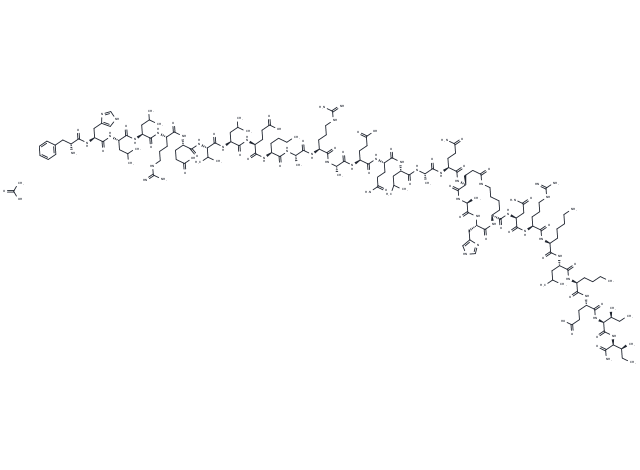Shopping Cart
- Remove All
 Your shopping cart is currently empty
Your shopping cart is currently empty

Astressin acetate is an antagonist of corticotropin releasing factor (CRF) with low affinity for the CRF binding protein and high affinity for the cloned pituitary receptor(Ki = 2 nM).

| Pack Size | Price | Availability | Quantity |
|---|---|---|---|
| 1 mg | $236 | In Stock | |
| 5 mg | $942 | In Stock | |
| 10 mg | $1,410 | In Stock | |
| 25 mg | $2,540 | In Stock |
| Description | Astressin acetate is an antagonist of corticotropin releasing factor (CRF) with low affinity for the CRF binding protein and high affinity for the cloned pituitary receptor(Ki = 2 nM). |
| In vitro | Astressin acetate exhibits high affinity for cloned human CRF-RA1 stably expressed in CHO cells and high potency to inhibit ACTH secretion[2]. |
| In vivo | Astressin acetate (i.c.v. 30 min before and 10 min after seizures) decreases damage in some hippocampal cell fields by as much as 84%. Astressin acetate protects even if administered only 10 min following excitotoxin exposure[1]. Astressin acetate is significantly more potent than any previously tested antagonist in reducing hypophyseal corticotropin secretion in stressed or adrenalectomized rats. Astressin acetate (30 and 100 μg/kg; i.v.) produces a significant decrease in ACTH levels at 45 and 90 min, respectively[2]. Astressin acetate significantly reverses the anxiogenic-like response induced by both social stress and i.c.v. rat/humanCRF (r/hCRF) on the elevated plus-maze, but fails to block the effects of r/hCRF-induced locomotor activity in a familiar environment[3]. |
| Alias | Astressin acetate (170809-51-5 Free base) |
| Molecular Weight | 3623.21 |
| Formula | C163H273N49O44 |
| Smiles | CC(O)=O.O=C(O)CC[C@H](NC([C@@H](NC([C@@H](NC([C@@H](NC([C@@H](NC([C@@H](NC([C@@H](NC([C@@H](NC([C@@H](NC([C@@H](NC([C@@H](NC([C@@H](NC([C@@H](NC([C@H](N)CC1=CC=CC=C1)=O)CC2=CNC=N2)=O)CC(C)C)=O)CC(C)C)=O)CCCNC(N)=N)=O)CCC(O)=O)=O)C(C)C)=O)CC(C)C)=O)CCC(O)=O)=O)CCCC)=O)C)=O)CCCNC(N)=N)=O)C)=O)C(N[C@@H](CCC(N)=O)C(N[C@@H](CC(C)C)C(N[C@@H](C)C(N[C@@H](CCC(N)=O)C(N[C@@H](CC3)C(N[C@@H](C)C(N[C@@H](CC4=CNC=N4)C(N[C@H](C(N[C@@H](CC(N)=O)C(N[C@@H](CCCNC(N)=N)C(N[C@@H](CCCCN)C(N[C@@H](CC(C)C)C(N[C@@H](CCCC)C(N[C@@H](CCC(O)=O)C(N[C@@H]([C@@H](C)CC)C(N[C@@H]([C@@H](C)CC)C(N)=O)=O)=O)=O)=O)=O)=O)=O)=O)CCCCNC3=O)=O)=O)=O)=O)=O)=O)=O)=O |
| Storage | store at low temperature,keep away from moisture | Powder: -20°C for 3 years | In solvent: -80°C for 1 year | Shipping with blue ice. |

Copyright © 2015-2025 TargetMol Chemicals Inc. All Rights Reserved.